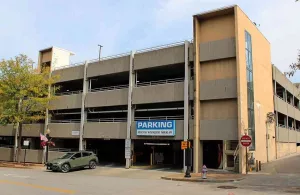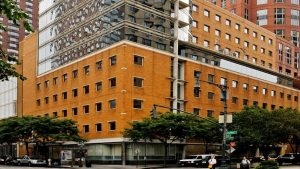Workers ready to restart high-risk demolition at Hanford halted after 2017 contamination spread
Published by John on
Richland, WA
High risk demolition of a radioactively contaminated plant at Hanford could restart in a week, nearly two years after a stop-work order was issued.
It will be the first work on the most contaminated portions remaining of the Plutonium Finishing Plant since particles of plutonium became airborne in December 2017, contaminating workers and the environment.
Some Department of Energy officials have said it is the most hazardous demolition project in the DOE complex nationwide.
Workers at the nuclear reservation have spent the last six months on lower risk demolition of the main plant, which was not under the stop work order
That part of the project was completed Wednesday.
Workers used the same processes that are planned for the higher risk work at the main plant, providing experience for the workers and increasing confidence that the remaining work can be done safely.
“We are confident these proven controls will be effective in keeping Hanford Site personnel and the public safe during the final phase of demolition activities,” said Ty Blackford, president of Hanford contractor CH2M Hill Plateau Remediation Co., in a message to his employees Thursday morning.
Weather delayed demolition
Hanford regulators — the Washington state Department of Ecology and the Environmental Protection Agency — issued an order after the contamination spread prohibiting a restart to the higher risk work at the plant until safety protocols were improved.
They lifted the order several months ago, clearing the way for the final phase of demolition after the completion of lower risk work on less contaminated areas of the plant.
“We think they have taken a lot of steps to really control the work in an improved manner,” said Theresa Howell, Plutonium Finishing Plant project manager for the Department of Ecology.
DOE also had to agree that the contractor was prepared to move forward with higher risk work and gave its approval in mid August.
“DOE is pleased with the efforts the contractor has made to keep the work proceeding at deliberate speed,” said Tom Teynor, DOE Hanford project director.
The lower risk demolition work was expected to be completed as soon as July, allowing higher risk demolition to start in the summer. But 2019 has been a difficult weather year at the nuclear reservation.
An unusually snowy winter, some heavy rains and days with high winds slowed progress.
About 90 percent of the main plant, which covered about 200,000 square feet and had areas that stood 67 feet tall, has been demolished.
Plant’s higher hazard work
The remaining higher-risk work includes demolishing the last 10 percent of the main facility and finishing up work at an annex to the plant, the Plutonium Reclamation Facility.
The part of the main building still standing includes a tunnel with piping for contaminated drain lines and the two processing lines.
During the Cold War the plant was used to process about two-thirds of the plutonium for the nation’s nuclear weapons program.
Plutonium came into the plant in a liquid solution. Workers in the two processing lines turned it into solids that could be sent to a weapons production plant.
Work with the plutonium was done in glove boxes, with workers looking through leaded glass windows and reaching their hands through gloves attached to portals to do the work inside the boxes.
When demolition work was halted at the Plutonium Finishing Plant in late 2017, about 95 percent of the Plutonium Reclamation Facility had been demolished. It once stood about six stories high, including what workers called its “penthouse.”
The facility was added to the main plant to recover plutonium from scrap material that otherwise would have gone to waste during the height of the Cold War. It was expected to be the most contaminated part of the Plutonium Finishing Plant when demolition began on it.
Only some stubs of its walls remain, plus contaminated debris that had not been packaged for removal before worked was halted in 2017.
Preventing plutonium spread
The debris has been covered with a pile of soil to prevent the spread of contamination until it is removed.
The spread of contamination is believed to be tied to demolition of the facility and the resulting debris, plus an incident earlier in 2017.
Some 42 workers inhaled or ingested small amounts of radioactive contamination from demolition of the plant. Several workers’ cars were contaminated with radioactive particles, including two that were driven home before the contamination was discovered.
Very small amounts of radioactive plutonium or americium were found to have spread from the plant for miles, with contamination found near the Columbia River and not far from Highway 240.
To ensure that the higher risk work is done more safely starting this fall, significantly more monitoring is being done.
Liberal use of water misting is planned during open-air demolition with heavy equipment. It is planned to keep contamination from becoming airborne and keep surfaces wet.
Fixative has been applied to walls to cover and secure contamination. Most glove boxes have been removed, and the contaminated piping has been filled with epoxy.
Contaminated building rubble will be loaded out each day rather than allowed to pile up as it did in 2017.
When workers get to the soil-covered debris left at the reclamation facility, they will use the dirt to create a mud bath to contain contamination as they load the mud and the debris out.
Demolition schedule
“The intent is to minimize the potential release of air-borne waste,” Teynor said. “Complacency is not part of the equation.”
Much of the building debris will can be packaged and disposed of at a lined landfill in the center of Hanford.
However, about 75 percent of the drain line piping that will be removed in the next phase of work is expected to have enough plutonium contamination that it will be sent for disposal to a national repository in New Mexico, the Waste Isolation Pilot Plant.
DOE’s tentative schedule for the higher risk work at the plant puts the completion of demolition of the main processing building in early January. Work at the Plutonium Reclamation Facility is expected to be finished in March.
The work will complete demolition of the plant down to its foundation.
Earlier work removed other parts of the Plutonium Finishing Plant complex, including the plant’s ventilation stack, the vaults where processed plutonium was stored and the the annex where worker Harold McCluskey was contaminated and injured by an explosion in 1976.




